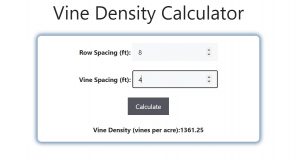About Vine Density Calculator (Formula)
A Vine Density Calculator is an essential tool for vineyard management, helping growers determine the optimal number of vines per acre based on specific spacing requirements. By accurately calculating vine density, vineyard owners can improve yield and enhance the overall quality of their grapes. This article will explore the formula for calculating vine density, provide guidance on how to use it, and present a practical example.
Formula
The formula for calculating vine density is VD = 43,560 / (RS * VS), where VD is the vine density (number of vines per acre), RS is the row spacing (in feet), and VS is the vine spacing (in feet).
How to Use
To use the Vine Density Calculator, follow these simple steps:
- Measure the row spacing (RS) in feet, which is the distance between the rows of vines.
- Measure the vine spacing (VS) in feet, which is the distance between each vine within a row.
- Plug these values into the formula: VD = 43,560 / (RS * VS).
- Calculate the vine density to determine how many vines can be planted per acre.
Example
Let’s consider a vineyard with a row spacing of 8 feet and a vine spacing of 4 feet. Using the formula:
- RS = 8 feet
- VS = 4 feet
VD = 43,560 / (8 * 4) = 43,560 / 32 = 1,363.75
In this case, approximately 1,363 vines can be planted per acre.

FAQs
- What is vine density? Vine density refers to the number of vines planted per acre in a vineyard, which influences the yield and quality of grapes produced.
- Why is vine density important? Proper vine density can optimize sunlight exposure, airflow, and nutrient allocation, leading to healthier vines and higher-quality grapes.
- How do I measure row spacing? Row spacing is measured as the distance between the center of one row of vines to the center of the adjacent row.
- What is the ideal vine spacing? Ideal vine spacing can vary based on grape variety, climate, and soil type, but common spacings are between 4 to 8 feet.
- Can I change my vine density after planting? While it’s challenging to alter vine density after planting, you can adjust management practices to improve growth and yield.
- How does vine density affect grape quality? Higher vine densities can lead to competition for resources, potentially affecting grape quality, while lower densities can allow for better individual vine development.
- What tools can I use to measure spacing? A tape measure or measuring wheel is commonly used to accurately measure row and vine spacing.
- Is there a recommended vine density for specific grape varieties? Yes, different grape varieties may have recommended vine densities based on their growth habits and environmental needs.
- What happens if my vine density is too high? High vine densities can lead to overcrowding, increased disease risk, and reduced fruit quality due to competition for resources.
- Can I use the Vine Density Calculator for other crops? While primarily designed for vineyards, the concept can be adapted for other crops, depending on the growth habits and spacing needs.
- How can I increase my vineyard yield? Adjusting vine density, improving soil health, and optimizing irrigation and pest management can help increase vineyard yield.
- What is the best spacing for high-density vineyards? High-density vineyards typically use spacing of 3 to 4 feet between vines and 6 to 8 feet between rows.
- How do environmental factors affect vine density? Factors such as soil fertility, water availability, and climate can impact the optimal vine density for a specific location.
- Is there a software available for vineyard planning? Yes, there are various software options that can assist with vineyard planning, including vine density calculations.
- What if my calculations yield a fraction? If your calculations result in a fraction, round to the nearest whole number, as you cannot plant a fraction of a vine.
- How does vine density impact pest management? Higher densities can increase the risk of pest outbreaks due to more crowded growing conditions.
- Is there a difference in management between low and high-density vineyards? Yes, low-density vineyards may require different pruning, training, and nutrient management compared to high-density vineyards.
- What is the significance of 43,560 in the formula? The number 43,560 represents the total square feet in one acre, which is necessary for calculating vine density per acre.
- Can I use this calculator for organic vineyards? Absolutely! The Vine Density Calculator is useful for all types of vineyards, including organic ones.
- Are there specific regulations on vine density? Regulations can vary by region; it’s important to check local agricultural guidelines when planning your vineyard.
Conclusion
Utilizing a Vine Density Calculator is crucial for successful vineyard management. By understanding and applying the formula for vine density, vineyard owners can make informed decisions that lead to healthier vines and higher quality grape production. Proper planning and spacing ensure a thriving vineyard that maximizes yield while maintaining grape quality.